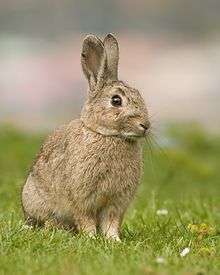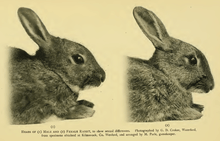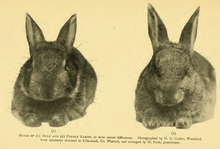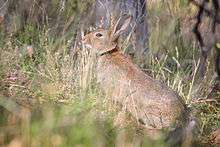European rabbit
| European rabbit[1] | |
|---|---|
 | |
| European rabbit | |
| Scientific classification | |
| Kingdom: | Animalia |
| Phylum: | Chordata |
| Class: | Mammalia |
| Order: | Lagomorpha |
| Family: | Leporidae |
| Genus: | Oryctolagus Lilljeborg, 1873 |
| Species: | O. cuniculus |
| Binomial name | |
| Oryctolagus cuniculus (Linnaeus, 1758) | |
 | |
| Range map | |
The European rabbit or common rabbit (Oryctolagus cuniculus) is a species of rabbit native to southwestern Europe (Spain and Portugal) and northwest Africa (Morocco and Algeria).[3] It has been widely introduced elsewhere, often with devastating effects on local biodiversity. However, its decline in its native range (caused by the diseases myxomatosis and rabbit calicivirus, as well as overhunting and habitat loss), has caused the decline of its highly dependent predators, the Iberian lynx and the Spanish imperial eagle. It is known as an invasive species because it has been introduced to countries on all continents with the exception of Antarctica, and caused many problems within the environment and ecosystems. Australia has the most problems with European rabbits, due to the lack of natural predators there.
The European rabbit is well known for digging networks of burrows, called warrens, where it spends most of its time when not feeding. Unlike the related hares (Lepus spp.), rabbits are altricial, the young being born blind and furless, in a fur-lined nest in the warren, and they are totally dependent upon their mother. Much of the modern research into wild rabbit behaviour was carried out in the 1960s by two research centres. One was the naturalist Ronald Lockley, who maintained a number of large enclosures for wild rabbit colonies, with observation facilities, in Orielton, Pembrokeshire. Apart from publishing a number of scientific papers, he popularised his findings in a book The Private Life of the Rabbit,[4] which is credited by Richard Adams as having played a key role in his gaining "a knowledge of rabbits and their ways" that informed his novel Watership Down. The other group was the Commonwealth Scientific and Industrial Research Organisation (CSIRO) in Australia, where numerous studies of the social behavior of wild rabbits were performed. Since the onset of myxomatosis, and the decline of the significance of the rabbit as an agricultural pest, few large-scale studies have been performed and many aspects of rabbit behaviour are still poorly understood.
Physical description


The European rabbit is a smallish, grey-brown (or sometimes black) mammal, although it ranks as medium-sized by lagomorph standards. It ranges from 34 to 50 cm (13 to 20 inches) in length, not counting a tail of 4 to 8 cm (1.6 to 3.1 in). Weight can range from approximately 1.1 to 2.5 kg (2.4 to 5.5 lb).[5] As a lagomorph, it has four sharp incisors (two on top, two on bottom) that grow continuously throughout its life, and two peg teeth on the top behind the incisors, dissimilar to those of rodents (which have only two each, top and bottom). Rabbits have long ears, large hind legs, and short, fluffy tails. Rabbits move by hopping, using their long and powerful hind legs. To facilitate quick movement, a rabbit's hind feet have a thick padding of fur to dampen the shock of rapid hopping. Their toes are long, and are webbed to keep from spreading apart as the animal jumps.
Ecology and behavior
Habitat

Rabbits are social animals, living in medium-sized colonies known as warrens. They are largely crepuscular, being most active around dawn and dusk, although they are not infrequently seen active during the day. During the day, rabbits prefer to reside in vegetated patches, which they use for protection from predators.[6] At night, they move into open prairie to feed.[6] Rabbit populations seem to be greatest in ecotone habitats and less in scrublands or grasslands.[7] Rabbits in grasslands are preyed on by carnivores. Ecotone rabbits are preyed on by both.[7]
Rabbits require at least 55% water content in their diet to reproduce successfully and to maintain a healthy condition.[8] Rabbits are essentially mixed-feeders, both grazing and browsing, but grass is their primary food source. They nevertheless have a diverse diet of grasses, leaves, buds, tree bark, and roots. They will also eat lettuce, cabbage, root vegetables, and grains. Birds of prey are their primary predators in scrublands.[7]
Social organization

Rabbits live in warrens that contain two to 10 other individuals living in smaller groups to ensure greater breeding success.[9] Territoriality and aggression contribute greatly to the rabbits maturation process and help ensure survival of the population.[10] Mature male and females are better at fighting off predators.[10] Females tend to be more territorial than males, although the areas most frequented by females are not defended.[11] Rabbits mark their territories with dung hills.[12] They expel soft, mucus-covered pellets that are sometimes reingested (coprophagy). They also expel larger pellets covered with secretions from the anal gland.[13] A rabbit’s success in repelling strangers depends on the potency of the pellets. When young rabbits leave their natal warrens, they either settle in their pre-existing territories, take over unoccupied, formerly established territories, or become transients.[14] Females tend to move into neighboring territories, while males tend to move further away.[14]
Rabbits can be extremely aggressive in the wild, and competition between males can often lead to severe injury and death. Although hostile displays are used, and males often squirt urine on challengers as a form of dominance, this nearly always enrages the challenger, resulting in immediate attack.[4] Rabbits use their powerful back legs as weapons, kicking at an opponent's underside, as well as biting and scratching with the front paws.
Reproduction
The male is called a buck and the female is a doe; a young rabbit is a kitten or kit.
The rabbit mating system is rather complex. Dominant males exhibit polygyny, whereas lower-status individuals (males and females) often form monogamous breeding relationships. Rabbits signal when they are ready to copulate by marking inanimate objects while giving off odoriferous substances though their chin gland, a process known as "chinning".[15] Dominance hierarchies exist in parallel for both males and females. Social rank is based on the amount of group aggression.[16] The dominant buck has greater mobility and more aggression than the dominant doe. This is likely because males have to fight each other for the females.[11] The social hierarchy of males is also determined by a number of other factors, such as the size of his patrol area, the number of females that visit his area, resting time near females, the number of shelters he visits, and the distance he travels daily.
Rabbits are famed for their reproductive capabilities. Although certainly not the strongest, fastest, or smartest of the mammals, they have carved out a strong ecological niche through their rate of impregnation, because female rabbits ovulate at the time of copulation. One striking example of rapid rabbit reproduction took place in Australia, where the first 24 rabbits introduced in 1859 had multiplied to form a population of over 600 million over the course of less than a century.[17][18]
The gestation cycle for a rabbit averages 31 days, although it can vary between 29 and 35 days. Litter sizes generally range between two and 12 rabbits. The young are born in a nesting burrow dug by the female, to which she returns once a day for four weeks for them to suckle.[19] The rabbit's reproductive abilities were the inspiration for the phrase "breeding like rabbits". They can reproduce from three to four months of age. They can produce four to seven litters of offspring per year; a mature female can be pregnant continuously for up to eight months. One single pair of mature rabbits is able to produce 30-40 offspring per year. Kittens are born in a nest in an isolated part of the warren. The females build, prepare and defend the nest. A doe will mark the nest with urine and fecal dropping to deter others from invading the site.[20] Does take care of the kittens without help from the bucks. However, bucks show considerable investment in the welfare of young, although much of this aspect of rabbit behavior is poorly understood. Males may be trying to enhance their social status by being surrounded by friendly individuals.[10]

Human relationship with rabbits
Recent research has shown that all European rabbits carry common genetic markers and descend from one of two maternal lines. These lines originated between 12,000 and 6.5 million years ago, when glaciers isolated two herds; one on the Iberian Peninsula and the other in Mediterranean France. It can be surmised that humans began hunting rabbits as a food source, but further research needs to be done to verify this. Little comprehensive evidence of the relationship of humans with European rabbits is documented until the medieval period.[21]
Humans' relationship with the European (sometimes called "true") rabbit was first recorded by the Phoenicians prior to 1000 BC, when they termed the Iberian Peninsula i-shaphan-ím (literally, the land of the hyraxes). This phrase closely resembles related modern Hebrew: i (אי) meaning island and shafan (שפן) meaning hyrax, plural shfaním (שפנים). Phoenicians called the local rabbits 'hyraxes' because rabbits resemble hyraxes in some ways, and were probably more common than rabbits in their native land (the Levant) at the time. Hyraxes, like rabbits, are not rodents. One theory states that the Romans converted the phrase i-shaphan-ím, with influence from the Greek Spania, to its Latin form, Hispania, which evolved into the modern Spanish word España (English "Spain"), and such other variations in modern languages. The precise meaning of shafan remains unclear, but the balance of opinion appears to indicate that the hyrax is indeed the intended meaning.[22]
The European rabbit is the only rabbit species that has been domesticated. All pet breeds of rabbits, such as dwarf lops and angoras, are of this species. However, rabbits and humans interact in many different ways beyond domestication. Rabbits are an example of an animal treated as a food, pet, and pest by members of the same culture. Urbanized European rabbits descended from pets have become pest problems in some cities. For instance, one of the northernmost populations of the species is now hosted by Helsinki, Finland, with an estimated 2,500 animals at the end of 2006 and 5,000 in autumn, 2007.[23] Finland's native lagomorphs are the European hare and the mountain hare. In Iceland, populations of O. cuniculus are also found in Reykjavik and in the Vestmann Islands.
As an invasive species
The European rabbit has been introduced as an exotic species into several environments, often with harmful results to vegetation and local wildlife, making it an invasive species. Such locations include Britain, where they were first introduced by the Romans following their invasion in AD 43;[24] (in November 2004 there were about 40 million European rabbits in the British Isles), Laysan Island (1903) and Lisianski Island in the Hawaiian Islands; Macquarie Island; Smith Island, San Juan Island (around 1900) later spreading to the other San Juan Islands; several islands off the coast of Southern Africa, one well-known example being that of Robben Island; Australia and New Zealand.

Twenty-four European rabbits were introduced to Australia in 1859 by estate owner Thomas Austin in Victoria. They soon spread throughout the country due to the lack of natural predators, widespread farming producing an ideal habitat, and mild Australian winters allowing them to breed year-round. Australia's equivalent to the rabbit, the bilby, was quickly pushed out by the rabbits. The bilbies are endangered, but are now making a comeback due to government protection. Between 1901 and 1907, Australia built an immense "rabbit-proof fence" to halt the westward expansion of the introduced rabbit population. The European rabbit can not only jump very high, but also burrow underground, making fencing essentially futile. During the 1950s, experiments with introduction of a virus, Myxomatosis cuniiculi, provided some relief in Australia, but not in New Zealand, where the insect vectors necessary for spread of the disease were not present. Myxomatosis can also infect pet rabbits of the same species. Today's remaining wild rabbits in Australia are largely immune to myxomatosis. The rabbit haemorrhagic disease virus has been cleared as a biological control agent against the European rabbit in Australia, and has already killed millions of the animals. It was also illegally introduced in New Zealand.
Domesticated rabbits
The only rabbit to be widely domesticated is the European rabbit, which has been extensively domesticated for food or as a pet. It was first widely kept in ancient Rome, where foetal rabbits were known as laurices and considered a delicacy, and has been refined into a wide variety of breeds during and since the Middle Ages.
Domesticated rabbits have mostly been bred to be much larger than wild rabbits, though selective breeding has produced a range sizes from "dwarf" to "giant", which are kept as food animals and pets across the world. They have as much colour variation among themselves as other livestock and pet animals. Their fur is prized for its softness; today, Angora rabbits are raised for their long, soft fur, which is often spun into yarn. Other breeds are raised for the fur industry, particularly the Rex, which has a smooth, velvet-like coat and comes in a wide variety of colors and sizes.
Status
Portuguese National Authorities (ICNB) have classified the rabbit as Near Threatened in Portugal, whilst Spanish authorities recently reclassified the rabbit as Vulnerable in Spain.[25] In 2008, the European Rabbit was re-classified by the World Conservation Union (IUCN) as "Near Threatened" in its native range due to the extent of recent declines[26]
Fossil record
The oldest fossils attributed to the modern European rabbit species are around 0.5 Ma old (Middle Pleistocene).[27]
See also
- American Rabbit Breeders' Association, a non-profit organization focused on all aspects of raising, keeping and exhibiting domestic European rabbits
- Cuniculture, the breeding and raising of domestic European rabbits
- House Rabbit Society, a non-profit organization dedicated to domesticated European rabbit care, education, information, and advocacy
- Rabbit show jumping, a sport involving domestic European rabbits
- Rabbits in Australia, information on the European rabbit's status as a pest in Australia
- Warren (domestic), man-made warrens used for the commercial breeding and raising of European rabbits for fur and meat from the medieval period onwards
- List of rabbit breeds
References
| Wikibooks Cookbook has a recipe/module on |
| Wikimedia Commons has media related to: |
| Wikispecies has information related to: Oryctolagus cuniculus |
- ↑ Hoffman, R.S.; Smith, A.T. (2005). "Order Lagomorpha". In Wilson, D.E.; Reeder, D.M. Mammal Species of the World: A Taxonomic and Geographic Reference (3rd ed.). Johns Hopkins University Press. pp. 205–206. ISBN 978-0-8018-8221-0. OCLC 62265494.
- ↑ Smith, A.T.; Boyer, A.F. (2008). "Oryctolagus cuniculus". IUCN Red List of Threatened Species. IUCN. 2008: e.T41291A10415170. doi:10.2305/IUCN.UK.2008.RLTS.T41291A10415170.en. Retrieved 27 August 2016.
- ↑ "ADW: Oryctolagus cuniculus: INFORMATION". Animal Diversity Web.
- 1 2 RM Lockley (1964), The Private Life of the Rabbit, Andre Deutsch
- ↑ Macdonald, D.W.; Barrett , P. (1993). Mammals of Europe. New Jersey: Princeton University Press. ISBN 0-691-09160-9.
- 1 2 Moreno, S. and R. D. Villafuerte, Migues (1996). "Cover is safe during the day but dangerous at night: the use of vegetation by European wild rabbit." Canadian Journal of Zoology 74:1656-1660.
- 1 2 3 Lombardi, L., N. Fernandez, et al. (2003). "Habitat-related Differences in Rabbit (Oryctolagus cuniculus) Abundance, Distribution, and Activity." Journal of Mammalogy 84(1):26-36.
- ↑ Clarke, G. M., Gross, S., Matthews, M., Catling, P. C., Baker, B., Hewitt, C. L., Crowther, D., & Saddler, S. R. 2000, Environmental Pest Species in Australia, Australia: State of the Environment, Second Technical Paper Series (Biodiversity), Department of the Environment and Heritage, Canberra.
- ↑ Daly, J. C. (1981). "Effects of Social Organization and Environmental Diversity on Determining the Genetic Structure of a Population of the Wild Rabbit, Oryctolagus cuniculus." Evolution 35(4): 689-706.
- 1 2 3 Dudzinski, M. L., R. Mykytowycz, et al. (1977). "Behavioral Characteristics of Adolescence in Young Captive European Rabbits, Oryctolagus cuniculus." Aggressive Behavior 3: 313-330.
- 1 2 Vastrade, F. M. (1987). "Spacing Behavior of Free-Ranging Domestic Rabbits, Oryctolagus cuniculus L." Applied Animal Behaviour Science 18:185-195.
- ↑ Mykytowycz, R. and M. L. Dudzinski (1972). "Aggressive and Protective Behaviour of Adult Rabbits Oryctolagus cuniculus (L.) Towards Rabbits." Behaviour 43: 97-120.
- ↑ Sneddon, I. A. (1991). "Latrine Use by the European Rabbit (Oryctolagus cuniculus)." Journal of Mammalogy 72(4): 769-775.
- 1 2 Kunkele, J. a. V. H., D. (1996). "Natal dispersal in the European wild rabbit." Animal Behavior 51:1047-1059.
- ↑ Gonzalez-Mariscal, G., M. E. Albonetti, et al. (1997). "Transitory inhibition of scent marking by copulation in male and female rabbits." Animal Behavior 53:323-333.
- ↑ Rodel, H. G., A. Bora, et al. (2004). "Density-dependent reproduction in the European rabbit: a consequence of individual response and age-dependent reproductive performance." Oikos 104:529-539.
- ↑ "The virus that stunned Australia's rabbits". Retrieved 2007-06-21.
- ↑ "Building a Rabbit "Bomb" in Australia" (PDF). SCDWS Briefs. 10 (4). January 1995.
- ↑ Hofmann,H: Wild Animals of Britain and Europe, HarperCollins 1995, pg.118-119 ISBN 0-00-762727-0
- ↑ Mykytowycz, R. and M. L. Dudzinski (1972). "Aggressive and Protective Behaviour of Adult Rabbits Oryctolagus Cuniculus (L.) Towards Rabbits." Behaviour 43:97-120.
- ↑ "History of Rabbit Domestication -- Western Europe".
- ↑ "The Camel, the Hare and the Hyrax, chapter 6" (PDF). Archived from the original (PDF) on June 16, 2012.
- ↑ Kemppainen, Jouni K. (October 2007). "Kanit keskuudessamme (The rabbits among us)". Suomen Kuvalehti (in Finnish): 76–83.
- ↑ "BBC NEWS - UK - England - Norfolk - Remains of Roman rabbit uncovered". bbc.co.uk.
- ↑ "SECEM 2006 red list" (PDF). secem.es.
- ↑ IUCN 2008 red list available at http://www.iucnredlist.org/apps/redlist/details/full/41291/0
- ↑ The Lagomorph Fossil Record and the Origin of the European Rabbit by Nieves Lopez-Martinez, 2008, Springer Berlin Heidelberg, Print ISBN 978-3-540-72445-2
- Reversing Rabbit Decline 2005 report concerning efforts to recover rabbits in Spain and Portugal, supported by the IUCN Lagomorph and Cat Specialist Groups
External links
- View the rabbit genome in Ensembl
- View the oryCun2 genome assembly in the UCSC Genome Browser.
